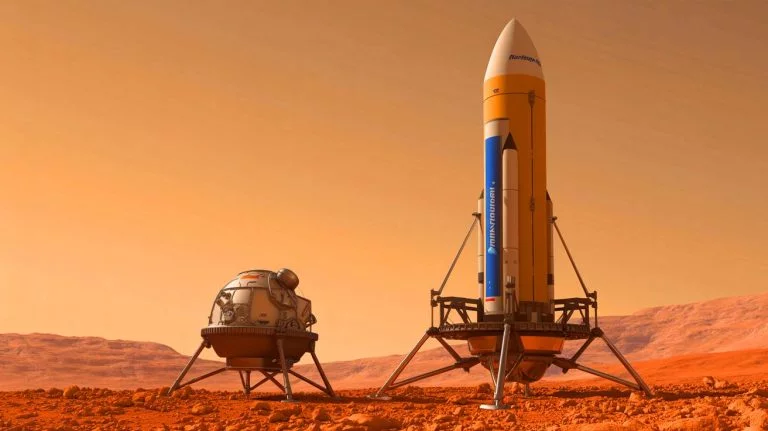| IN A NUTSHELL |
|
Northrop Grumman has taken a bold step toward a groundbreaking achievement in space exploration by successfully testing the rocket motor intended for the first-ever orbital launch from another planet. This mission, part of the ambitious Mars Sample Return (MSR) program, aims to bring geological samples from Mars back to Earth for comprehensive analysis. While the idea of launching a rocket from Mars sounds straightforward, the complexity involved is staggering, demanding meticulous planning and execution. The Mars Sample Return mission is a collaborative international effort, with NASA’s Perseverance rover already collecting and storing samples on the Martian surface, awaiting the next stages of this historic mission.
The Ambitious Mars Sample Return Mission
The Mars Sample Return mission represents one of the most ambitious undertakings in the history of space exploration. Its primary goal is to retrieve samples from the Martian surface and bring them back to Earth for detailed laboratory study. This mission is a joint effort involving multiple spacecraft, each with a crucial role in the overall success. NASA’s Perseverance rover is at the forefront, meticulously collecting soil and rock samples using its advanced robotic arm and drill system. These samples are then carefully stored in specialized vials and strategically placed on the Martian surface.
The logistical challenges of this mission are immense. The samples will remain on Mars for several years until a future landing craft arrives with a specially designed rover. This rover will retrieve the samples and secure them in a special container. The mission’s complexity underscores the need for precision and reliability at every stage, highlighting the importance of international collaboration and cutting-edge technology in space exploration.
Key Role of the Mars Ascent Vehicle (MAV)
The Mars Ascent Vehicle (MAV) is a pivotal component of the Mars Sample Return mission. It is designed to launch from the Martian surface, carrying the precious samples into orbit. Standing approximately 10 feet tall and weighing about 992 pounds, the MAV comprises two solid rocket stages, sophisticated avionics, sensors, and steering gear. This powerful vehicle is engineered to reach speeds of 2.5 miles per second, enabling it to place its payload into low Mars orbit within a mere 10 minutes.
Once in orbit, the MAV will rendezvous with another spacecraft, which will then transport the samples back to Earth. Recent tests conducted at Northrop Grumman’s Elkton, Maryland facility focused on evaluating the performance of the MAV’s second stage, particularly in conjunction with a new propellant mixture. This propellant, potentially an ammonium perchlorate composite with powdered aluminum fuel, is designed to withstand the harsh conditions of space and ensure planetary protection standards are met.
Innovative Testing and Proven Technology
The recent successful ground test of the MAV motor marks a significant milestone in the Mars Sample Return mission. During the test, the rocket spun rapidly, indicating that it will likely be spin-stabilized to maintain its trajectory during the Martian launch. This innovative approach enhances the vehicle’s stability and accuracy, crucial for its success.
According to Jeff Bemis, program manager of the Mars Ascent Propulsion System (MAPS) program at Northrop Grumman, this test demonstrates a near-flight-ready design using proven space materials and propellants. The materials and propellants used have a legacy of reliability and are well-suited for the extreme conditions of space, aligning with current planetary protection requirements. This underscores Northrop Grumman’s commitment to leveraging experience and expertise in aerospace technology to achieve groundbreaking accomplishments in space exploration.
Looking Ahead: The Future of Mars Exploration
As Northrop Grumman continues to refine the technology for the Mars Sample Return mission, the potential for new discoveries and insights into the Red Planet is immense. The successful return of Martian samples could provide invaluable data about Mars’s geological history, climate, and potential for past life. This mission represents a significant leap forward in our understanding of Mars and our capability to conduct complex interplanetary missions.
The Mars Sample Return mission is a testament to human ingenuity and the relentless pursuit of knowledge. As we stand on the cusp of launching a rocket from another planet, one can’t help but wonder: what other mysteries of the universe are waiting to be uncovered, and how will these discoveries shape the future of space exploration?
Did you like it? 4.5/5 (27)







Isn’t $10 billion too much for just dirt? 🤔
Finally, some space news that’s out of this world! 🚀
Why so much criticism? This is a huge leap for mankind!
Can’t wait to see what secrets Mars holds. 🛸
Hope they don’t forget the samples on Mars. 😅
How long will it take for the samples to arrive back on Earth?
I’m skeptical about the cost, but the science sounds fascinating.
Will the samples be available for public study?
Seems like a gamble, but isn’t all exploration risky?
Thank you for the detailed article on such a complex topic!
Excited about the potential discoveries! 🌌
This mission is ambitious, but the risks seem too high.
What’s the backup plan if the ascent vehicle fails?
Hope the samples don’t get contaminated on the way back. 🚀
Isn’t it more cost-effective to study Mars with rovers?
Interesting read, but I’m still not convinced it’s worth $10 billion.
Shouldn’t we focus on fixing issues on Earth first? 🌍
It’s like a sci-fi movie coming to life!
Thank you for the insight. Fascinating stuff!
Wish I could be a part of this mission!
Why is the MAV spin-stabilized? How does it work?
This is a significant step forward in space exploration. 👏
Looks like a huge risk for just some rocks and soil.
Good luck to the team! This is exciting. 🚀
How are they ensuring planetary protection during this mission?
Great article! Can’t wait to see what they discover! 😊
Are other countries involved in this mission?
Seems like a lot of money for little return. 🤷♂️
Is there a timeline for when the samples will be analyzed?
Northrop Grumman is really pushing the boundaries with this one.
Why not invest this money into more pressing matters on Earth?
The risks are high, but the rewards could be groundbreaking.
How do they choose which samples to bring back?
Hope this mission ignites more interest in space exploration! 🌠
Great work, Northrop Grumman! Keep reaching for the stars! 🌟